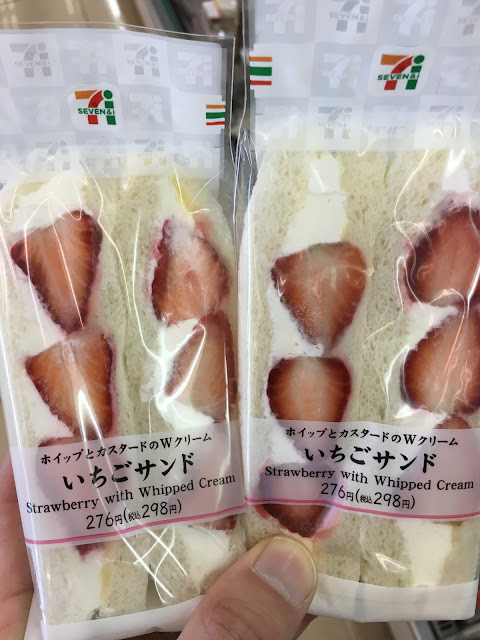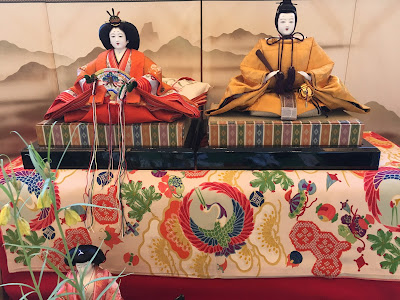
When once thinks of everyday food in Japan, rice is the first thing that comes to mind. However, bread is also hugely popular; indeed, your
typical busy Japanese is probably just as likely to have toast and coffee for breakfast as rice! The Japanese have a
traditional breakfast (rice, soup, fish, vegetables
etc) about as often as a Brit enjoys a full English breakfast (
i.e. not very often). The word for bread in Japanese is
pan (パン), the same as Spanish, though the word itself reportedly
came from Portuguese pão since it was the Portuguese who introduced bread
in the 16th century. See
here for a brief history of bread in Japan.

Today, bakeries are everywhere in Japan and the variety of bread products is mouth-watering. The system is help-yourself; on entering a bread shop you pick up a tray
and a pair of tongs and pick out what you want. You then take the tray
over to the cash register (
reji =レジ) and they will put your selections into separate bags and total them up. In the UK it's more common to point out what you want to the shopkeeper who will then bag up your requests. Interestingly, there are some in hygiene-conscious who dislike the fact that everything is open to customer's whims (and their coughs and sneezes - just like
oden) but most people don't seem to mind.
 |
| Tsubu-an doughnuts: all sold out |

Two of my Japanese bakery favourites are
an-pan (red bean paste or
anko bread) and
kare-pan (curry bread). The former is made from azuki beans (小豆) and comes in two kinds:
tsubu-an (containing lumps -
tsubu or 粒 is the counter for small round objects) and
koshi-an (smooth). Japanese tend to fall into one camp or the other and there is
much argument over which is better. Different breads also appear in different seasons: because now is
cherry blossom time,
sakura (cherry)
an-pan are on sale. As the picture shows, these have a real salt-pickled (
shio-zuke =塩漬け) edible cherry petal on top and the bread has a pink tinge. Anpanman is also the name of one of Japan's most popular characters with a
full bakery cast that includes Karepanman, Shokupanman, Melonpanna, Creampanda, and many more!


My second favourite bread is
kare-pan, deep-fried pirozhki-style bread with curry sauce inside which first appeared in 1972. Sometimes they contain extra fillings as well as curry such as the ones pictured which have a soft-boiled coddled egg (
hanjuku-tamago =半熟卵) inside. Delicious!

As a Brit, I was interested to discover
the special kind of bread known as igirisu-pan or "English bread" when I first arrived. This is basically a plain white "mountain-shaped" (
yama-gata =山型) loaf which is usually sold not as a whole loaf but in packs of six or eight slices. This is
distinguished from the cheaper
shoku-pan (食パン) often sold in convenience stores which is less airy and more dense (
kime ga araku =キメが粗く) and often contains butter and sugar (pictured). But despite "English bread" being a staple in both Japan and the UK, the types of sandwiches eaten are not always the same; Japanese are usually shocked by the traditional British
chip "butty" (fried potato sandwich) while this Brit may has never got used to
yaki-soba (fried noodle) pan and the stomach-churning Japanese fruit and whipped cream sandwich (pictured). Vive la difference!
 When once thinks of everyday food in Japan, rice is the first thing that comes to mind. However, bread is also hugely popular; indeed, your typical busy Japanese is probably just as likely to have toast and coffee for breakfast as rice! The Japanese have a traditional breakfast (rice, soup, fish, vegetables etc) about as often as a Brit enjoys a full English breakfast (i.e. not very often). The word for bread in Japanese is pan (パン), the same as Spanish, though the word itself reportedly
came from Portuguese pão since it was the Portuguese who introduced bread
in the 16th century. See here for a brief history of bread in Japan.
When once thinks of everyday food in Japan, rice is the first thing that comes to mind. However, bread is also hugely popular; indeed, your typical busy Japanese is probably just as likely to have toast and coffee for breakfast as rice! The Japanese have a traditional breakfast (rice, soup, fish, vegetables etc) about as often as a Brit enjoys a full English breakfast (i.e. not very often). The word for bread in Japanese is pan (パン), the same as Spanish, though the word itself reportedly
came from Portuguese pão since it was the Portuguese who introduced bread
in the 16th century. See here for a brief history of bread in Japan. Today, bakeries are everywhere in Japan and the variety of bread products is mouth-watering. The system is help-yourself; on entering a bread shop you pick up a tray
and a pair of tongs and pick out what you want. You then take the tray
over to the cash register (reji =レジ) and they will put your selections into separate bags and total them up. In the UK it's more common to point out what you want to the shopkeeper who will then bag up your requests. Interestingly, there are some in hygiene-conscious who dislike the fact that everything is open to customer's whims (and their coughs and sneezes - just like oden) but most people don't seem to mind.
Today, bakeries are everywhere in Japan and the variety of bread products is mouth-watering. The system is help-yourself; on entering a bread shop you pick up a tray
and a pair of tongs and pick out what you want. You then take the tray
over to the cash register (reji =レジ) and they will put your selections into separate bags and total them up. In the UK it's more common to point out what you want to the shopkeeper who will then bag up your requests. Interestingly, there are some in hygiene-conscious who dislike the fact that everything is open to customer's whims (and their coughs and sneezes - just like oden) but most people don't seem to mind.
 Two of my Japanese bakery favourites are an-pan (red bean paste or anko bread) and kare-pan (curry bread). The former is made from azuki beans (小豆) and comes in two kinds: tsubu-an (containing lumps - tsubu or 粒 is the counter for small round objects) and koshi-an (smooth). Japanese tend to fall into one camp or the other and there is much argument over which is better. Different breads also appear in different seasons: because now is cherry blossom time, sakura (cherry) an-pan are on sale. As the picture shows, these have a real salt-pickled (shio-zuke =塩漬け) edible cherry petal on top and the bread has a pink tinge. Anpanman is also the name of one of Japan's most popular characters with a full bakery cast that includes Karepanman, Shokupanman, Melonpanna, Creampanda, and many more!
Two of my Japanese bakery favourites are an-pan (red bean paste or anko bread) and kare-pan (curry bread). The former is made from azuki beans (小豆) and comes in two kinds: tsubu-an (containing lumps - tsubu or 粒 is the counter for small round objects) and koshi-an (smooth). Japanese tend to fall into one camp or the other and there is much argument over which is better. Different breads also appear in different seasons: because now is cherry blossom time, sakura (cherry) an-pan are on sale. As the picture shows, these have a real salt-pickled (shio-zuke =塩漬け) edible cherry petal on top and the bread has a pink tinge. Anpanman is also the name of one of Japan's most popular characters with a full bakery cast that includes Karepanman, Shokupanman, Melonpanna, Creampanda, and many more! My second favourite bread is kare-pan, deep-fried pirozhki-style bread with curry sauce inside which first appeared in 1972. Sometimes they contain extra fillings as well as curry such as the ones pictured which have a soft-boiled coddled egg (hanjuku-tamago =半熟卵) inside. Delicious!
My second favourite bread is kare-pan, deep-fried pirozhki-style bread with curry sauce inside which first appeared in 1972. Sometimes they contain extra fillings as well as curry such as the ones pictured which have a soft-boiled coddled egg (hanjuku-tamago =半熟卵) inside. Delicious! As a Brit, I was interested to discover the special kind of bread known as igirisu-pan or "English bread" when I first arrived. This is basically a plain white "mountain-shaped" (yama-gata =山型) loaf which is usually sold not as a whole loaf but in packs of six or eight slices. This is distinguished from the cheaper shoku-pan (食パン) often sold in convenience stores which is less airy and more dense (kime ga araku =キメが粗く) and often contains butter and sugar (pictured). But despite "English bread" being a staple in both Japan and the UK, the types of sandwiches eaten are not always the same; Japanese are usually shocked by the traditional British chip "butty" (fried potato sandwich) while this Brit may has never got used to yaki-soba (fried noodle) pan and the stomach-churning Japanese fruit and whipped cream sandwich (pictured). Vive la difference!
As a Brit, I was interested to discover the special kind of bread known as igirisu-pan or "English bread" when I first arrived. This is basically a plain white "mountain-shaped" (yama-gata =山型) loaf which is usually sold not as a whole loaf but in packs of six or eight slices. This is distinguished from the cheaper shoku-pan (食パン) often sold in convenience stores which is less airy and more dense (kime ga araku =キメが粗く) and often contains butter and sugar (pictured). But despite "English bread" being a staple in both Japan and the UK, the types of sandwiches eaten are not always the same; Japanese are usually shocked by the traditional British chip "butty" (fried potato sandwich) while this Brit may has never got used to yaki-soba (fried noodle) pan and the stomach-churning Japanese fruit and whipped cream sandwich (pictured). Vive la difference!
























